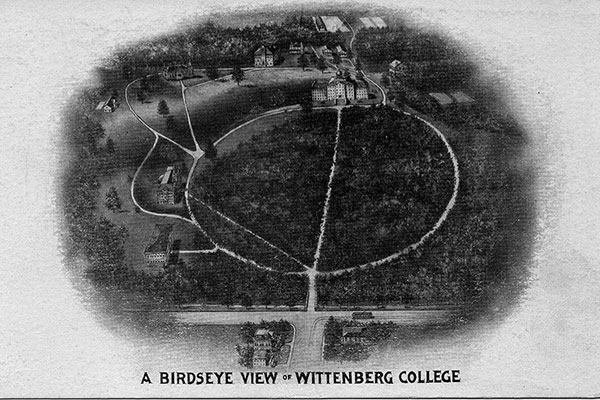 No, it is not an alien landing site.
No, it is not an alien landing site.
No, it is not a crop circle.
It is an aerial view of Wittenberg College.
Aerial photography began in the 1800s, first using balloons (late 1850s) and then kites (1880s). It expanded with the invention of powered flight after 1903 and grew dramatically in the 1910s, due partly to the First World War.
This wonderful postcard may have been based on a photo, but it is a drawing and it is undated. So what does it show, and when was it made?
At the bottom is the south entrance to the campus, with the Prince residence on the right and the early brick house called Ferncliff on the left. Where the central path intersects the circle, we see no evidence of the entrance walls given by the class of 1911.
Note that the campus development is all on the left (west) and top (north) sides, so this view precedes the 1920s expansion (like Blair and Koch). Moving from the entrance around the circle to the left, we see Carnegie Science Hall (1908), so this view is no earlier than 1908.
Following the path around, we pass Recitation (1880s) and then two paths take us up the slope, one to the first gym (far left) and the other to Zimmerman Library (1891).
To the right of Zimmerman lies Keller Hall, home of the seminary, built in 1901.
At the top of the circle and the central axis pathway is our Myers Hall. Note, however, that it lacks the front columns. So this is “Old Wittenberg” before it was renovated and re-named “Myers Hall” in the mid 1910s. (Note that it is presented in its 1800s colors of white or cream, rather than the later dark color (various shades of red), though in a drawing we might not take that choice too literally.
So this postcard image represents Wittenberg in the 1908-1915 era, perhaps closer to 1910. This particular postcard has a note on the back but no postmark or date. Likely as not, some collector has a postmarked version that would narrow down the dating.
About The Project
With Wittenberg now celebrating its 175th year, and the University unable to hold regular in-person classes as a result of the COVID-19 pandemic, Professor of History Thomas T. Taylor has started circulating several pieces on Wittenberg's history. Some originated in earlier series, either This Month in Wittenberg History or Happy Birthday Wittenberg. Others have their origin in the Wittenberg History Project or in some other, miscellaneous project. Sincerest thanks to Professor Taylor for connecting alumni, faculty, staff, and students through a historic lens.

